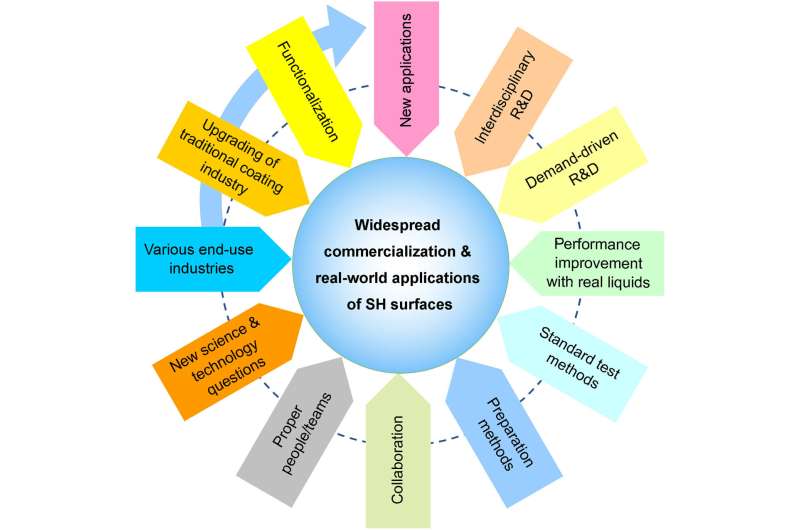This article has been reviewed according to Science X's editorial process and policies. Editors have highlighted the following attributes while ensuring the content's credibility:
fact-checked
peer-reviewed publication
trusted source
proofread
Exploring the potential and applications of superhydrophobic surfaces

Researchers led by Prof. Zhang Junping from the Lanzhou Institute of Chemical Physics of the Chinese Academy of Sciences have discussed the challenges and strategies for commercialization and widespread practical applications of superhydrophobic surfaces. The review article was published in Science Advances on Oct. 20.
Superhydrophobic surfaces feature high water contact angle (≥150°) and low contact angle hysteresis (≤10°) or sliding angle (≤10°). In the past 20 years, advances have been made in fundamental research of superhydrophobic surfaces, such as preparation, bionics, wettability theory and potential applications.
Preparation methods based on the design of surface structures and the discovery or synthesis of low-surface-energy materials have been developed, and various micro-, nano- and hierarchical micro-/nanostructures have been constructed. Lithography, etching, templating, deformation, and deposition are the most commonly used techniques, and new techniques are constantly being developed.
Researchers have suggested numerous potential applications of superhydrophobic surfaces, such as the fields of self-cleaning, oil/water separation, corrosion protection, anti-/deicing and water-proof textiles.
"However, the widespread practical applications of superhydrophobic surfaces lag considerably behind their vibrant fundamental research," said Prof. Zhang, corresponding author of the article.
The researchers first presented the findings of a survey on the current state of superhydrophobic surfaces including fundamental research, patenting, and commercialization. Based on the survey and their experience, they explored the challenges and strategies for commercialization and widespread practical applications of superhydrophobic surfaces.
They found that the comprehensive performances, preparation methods and application scenarios of superhydrophobic surfaces are the major constraints. These challenges should be addressed simultaneously, and actionable strategies including performance improvement, standard test methods, demand-driven R&D and developing various end-use industries were provided.
Moreover, they highlighted standard test methods of comprehensive performances including mechanical stability, impalement resistance and weather resistance, and discussed the prospects of superhydrophobic surfaces in the future.
"We anticipate that superhydrophobic surfaces may be widely commercialized and used in practical applications around the year 2035 through combination of the suggested strategies and input from both academia and industry," said Prof. Zhang.
More information: Lingxiao Li et al, Challenges and strategies for commercialization and widespread practical applications of superhydrophobic surfaces, Science Advances (2023). DOI: 10.1126/sciadv.adj1554
Journal information: Science Advances
Provided by Chinese Academy of Sciences





















